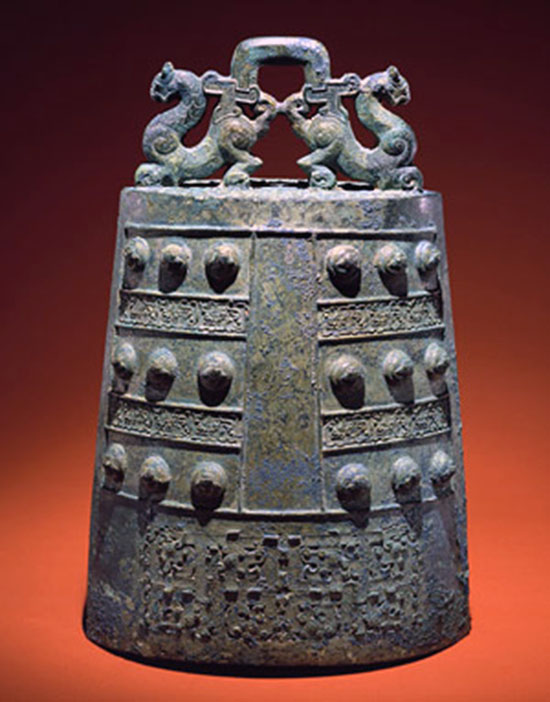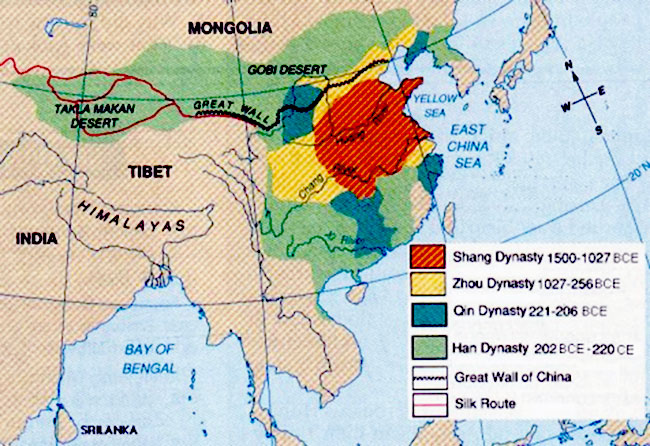When the Zhou dynasty usurped the throne from the Shang dynasty, China itself was split into several states. The Shang, in fact, only had power over a relatively small region in the Yellow River area. The Zhou occupied an area to the west of the Shang kingdom, but when the Zhou kings overthrew the Shang, the Zhou kingdom became very large.
The Shang dynasty had degenerated morally; the last of the Shang kings, Di Xin (King Zhou), was totally corrupt. The Zhou usurpers, on the other hand, King Wen (1075-1046) and his son, King Wu (1046-1043), were virtuous and “followed the moral ways of heaven”. Zhou were largely regarded as barbarians by the Shang. They seem to be a stone-age people occupying the area around the city of Sian on the Wei River. Shang dynasty was severely weakened in its constant warfare with peoples to the north who encroached on Shang territory. The Zhou took advantage of this weakness in 1050 to overthrow the Shang.
The Zhou, seem to have adopted Shang life and Shang government, so that there was really no difference between the two dynasties. As under the Shang, government was largely in the hands of city-states; since the territory greatly expanded after the Zhou invasion, the number of city-states under the king probably numbered around two hundred to two hundred and fifty. The Zhou adopted the agriculture of the Shang as well as Shang writing. Because of the existence of slaves, the handicraft industry developed quickly. The production of bronze wares was done on a large scale. In textiles and architecture, there were also great progresses.



The Zhou, however, governed somewhat differently. Although the basic political unit was the city-state, the Zhou appointed their own kinsmen, or the kinsmen of their mosted trusted allies, to rule over the various city-states. The Zhou had learned from their own successful usurpation of Shang power: much of the Zhou success was due primarily to their winning-over of disaffected city-states against the Shang. The Zhou also established two capitals, one their traditional capital in the west, and a second one in the east at Loyang on the Yellow River.
Doctrine of the Zhou dynasty
The Zhou also had to contend with the validity of their rule. In order to convince their subject peoples, especially the nobles, of the legitimacy of their power, the Zhou invented a new system of authority which they called t’ien ming (tianming), or “the Mandate of Heaven.” This concept is still an integral aspect of Chinese theories of authority. The Zhou defined the kingship as an intermediary position between heaven and earth; the Chinese character for emperor or lord, “ti,” demonstrates this eloquently. The ideograph consists of three horizontal lines joined by a vertical line. This represents the connection between heaven (at the top) and the earth (at the bottom). This relationship is mediated by the lord or emperor (the center horizontal line). Heaven (“t’ien”) desires that humans be provided for in all their needs, and the emperor, according to the idea of “t’ien ming” is appointed by heaven to see to the welfare of the people. This is the “Decree” or “Mandate” of heaven. If the emperor or king, having fallen into selfishness and corruption, fails to see to the welfare of the people, heaven withdraws its mandate and invests it on another. The only way to know that the mandate has passed is the overthrow of the king or emperor; if usurpation succeeds, then the mandate has passed to another, but if it fails, then the mandate still resides with the king.
The Mandate of Heaven is probably the most critical social and political concept in Chinese culture. It explains historical change, but also provides a profound moral theory of government that is based on the selfless dedication of the ruler to the benefit of the general population. The concept also recreates the Chinese concept of Heaven, which was derived from the earlier concept of a “Lord on High,” or “Shang-Ti,” into a force that regulates the moral universe. It is this moral aspect of Heaven and the “Mandate of Heaven,” which was to affect the general tendency of Chinese culture and philosophy to focus on moral and social issues—more so than any other ancient culture.
The Eastern Zhou



Around 771 BC, northern tribes overran the western Zhou and conquered their capital city. The Zhou king was killed, but his son, the heir to the throne, fled to Loyang and established his government there. This begins the period of the Eastern Zhou dynasty, which was to last until its overthrow by the Ch’in dynasty in 256 BC. In Chinese history, this period is called “the Spring and Autumn period” (771-401 BC) and the “Warring States Period” (401-256 BC). This era of the Eastern Zhou would also see the most energetic flowering of Chinese thought and culture in Chinese history. For it is during the reign of the Eastern Zhou that the greatest philosophers established the rudiments of Chinese philosophy, ethics, political theory, and culture.
In the Spring and Autumn period (771-401 BC), China largely consisted of a group of minimally powerful kingdoms. The Zhou themselves never regained enough military or political power to reconquer the west or even to maintain much control over the city-states they ruled over. Because of the instability of these kingdoms, and because of the encroachments on their territories by barbarian tribes to the south, the smaller territories entered into alliances with one another and agreed to have certain territorial lords rule over them as “hegemons.” So the Spring and Autumn period was one of great uncertainty and danger, in which territory shifted back and forth, invasions were frequent, and alliances formed and dissolved with astonishing rapidity.
